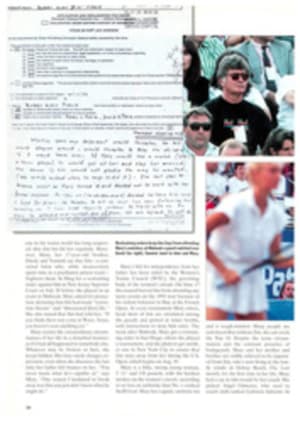
FROM THE MANAGING EDITOR
When SPORTS ILLUSTRATED commissioned Artist Brent Benger in May to create paintings of five future baseball Hall of Famers (page 38), Benger found his muse on Southern California's Golden State Freeway. It seems the 28-year-old native of Long Beach gets many of his ideas while behind the wheel. "My inspiration has a lot to do with being in L.A.," he says. "When you're trapped in traffic, there's not much you can do except think."
Benger, who says he has been influenced by the homespun realism of Norman Rockwell, specializes in sports art. His previous work includes oil paintings of Evander Holyfield and L.A. Dodgers Orel Hershiser and Eric Karros, and he is currently working on a painting of World Boxing Council champion Lennox Lewis. However, before brushstroking boxers (Holyfield was his first commission, in 1990), Benger did time as a Hollywood mat artist, painting movie backgrounds for such films as Gremlins II and Dark Man. "I got tired of all the clouds and trees," Benger says of the scenery he painted. "What I really wanted to do was paint people."
As a kid Benger hoped he would someday be wearing pinstripes, not painting them, but he realized soon enough that "there probably wasn't going to be a place in the major leagues for a short, slow guy who hit .240. So instead of playing baseball, I paint it."
The process is often painstaking. Each of the paintings for SI—of Nolan Ryan, Dave Winfield, Ozzie Smith, George Brett and Sparky Anderson—required six well-planned stages. Benger began by sketching a scene in a notebook using stick figures. He then posed and photographed each athlete, as well as the models he used for the background figures.
Not all the characters in each painting were available to be photographed at the same time. In the painting of Anderson, for instance, the Detroit manager was photographed arguing with the air because there was no umpire available at the time of the Tiger Stadium shoot. It wasn't until a week later that umpire Ken Kaiser posed for Benger in Anaheim.
In step 3, Benger sketched a charcoal study from the assembled photographs, then shot another set of photos of the charcoal study. Only after he had established his color scheme by painting directly onto the black-and-white prints did he finally put brush to canvas. Ordinarily this six-step process takes him up to six weeks per painting. To meet SI's deadline, he sometimes had to work around the clock; he completed all the paintings in just three months.
Benger, who thinks of these paintings as story portraits, believes in the communicative power of art. "I'm a storyteller," he says. "If Mark Twain had been a painter, that's who I'd be."
PHOTO
CRAIG MOLENHOUSE
Benger, shown in his studio, figured that if he couldn't wear pinstripes, he could paint them.

